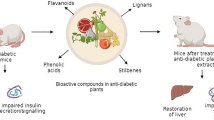Abstract
Dietary spice components ofCurcuma longa andAbroma augusta have been screened for their protective effect against reactive oxygen species induced lipid peroxidation. They have been found to be efficient antioxidant when administered in combination. The purpose of the study was to investigate the effect of oral administration (300mg/Kg) of the aqueous extract of turmeric whose active ingredient isCurcumin andAbromine powder as a hypoglycemic agent mixed with diet. The effect of this aqueous extract on blood glucose, lipid peroxidation (LPO) and the antioxidant defense system in rat tissues like liver, lung, kidney and brain was studied for 8 weeks in streptozotocin induced diabetic rats. The administration of an aqueous extract of turmeric and abromine powder resulted in a significant reduction in blood glucose and an increase in total haemoglobin. The aqueous extract also resulted in decreased free radical formation in the tissues studied.
The decrease in thiobarbituric acid reactive substances (TBARS) and increase in reduced glutathione (GSH), superoxide dismutase (SOD) and catalase (CAT) clearly showed the antioxidant property of the mixture. It is suggested that these changes initially counteract the oxidative stress in diabetes however, a gradual decrease in the antioxidative process may be one of the factors which results in chronic diabetes. These results indicate that the mixture of the two plants have shown antidiabetic activity and also reduced oxidative stress in diabetes. A combination ofAbroma augusta and Curcuma longa also restored the other general parameters in diabetic animals. The results were statistically analyzed and indicated that combination of herbal extracts showed better efficacy as compared to individual herbal plant extracts used.
Similar content being viewed by others
References
Melinda A., (1988) Non insulin dependent diabetes mellitus treatment with sulphonylureas in Clinical Endocrinology and metabolism. Des natures, M. and Hale, P. Balliere- Tindall, London.; P, 443–453.
World Health Organization. (1980) Expert committee diabetes mellitus. Technical Report Second Series. No. 646, WHO, Geneva, p. 61.
Satyavati, G. V. and Gupta, A. K. (1987) Medicinal plants of India eds Indian Council, New Delhi: Vol. II. Shankar, TNB; Shanta N. V., Ramesh. H.P.; Murthy I.A.S., Murthy V.S., 1987 Ind. J. Exp. Biol. 1980; 18, 73.
Oubre, A.Y., Carlson, T.J., King, S.R. and Reaven, G.M. (1970) from plant to patient, an Ethanomedical approach to the identification of new drugs for the treatment of NIDDM. Diabetologia; 40 (5): 614–617.
Shnkar, TNB; Shanta N.V., Ramesh, H.P.; Murthy I.A.S. Murthy V.S. (1980). Toxicity Studies on Turmeric (Cuecuma longa): Acute Toxicity studies in rats, Guineapigs&Monkeys. Ind. J. Exp. Bio. 1980; 18 (1): 73–75.
Shih, C.A., Lin J.K. (1980) Inhibition of 8-Hydroxydeoxyguanosive formation by curcumin in mouse fibroblast cells. carcinogenesis; 14 (4) 709–712
Tank, R., Sharma, N., Sharma, I., Dixit, VP (1989) Anti-diabetic activity ifC.longa in alloxan Induced diabetic rats—Indian drugs: 27 (11) 587–589.
Hakino, H. (1985) Anti hepatotoxic activity of crude drugs. Yakugaku Zasshi. 105 (2) 109–118.
Soudamini, K. K., Kuttan, R. (1989) Inhibition of chemical carcinogenesis by Curcumins. J. Ethnopharmacology; (27): 227–233.
Hussein, H.E.M.A., Jamil, K. and Rao, M. (2001) Preliminary studies on the Hypoglycemi effect ofAbroma augusta in alloxan diabetic rats. Ind. J. clin. Biochem. 16 (1). 77–80.
Poliodoro, G.D.T., Arduini, R.G.L.A. and Federici, G. (1984) Superoxide dissimulates, reduced Glutathione and TBA-reactive products in erythrocytes of patients with multiple sclerosis. Int. J. Biochem. 16 (50): 505–509.
Hiroshi, O., Nobuko, O. and Kunio, V. (1979) Assay for lipid peroxides in animal tissues by thiobarbituric acid reaction. Anal. Biochem. 5, 351–358.
Wendell, A. (1981) Glutathione peroxidase. In: Methods in Enzymology, Ed. Jakoby, W.B. Academic Press, New York, USA Vol. (77): P. 327–333.
Hussein, H.E.M.A., Jamil, K. and Rao, M. (2001) Hypoglycemic, hypolipidemic and antioxidant properties of tulsi (Ocimumsanctum Linn) on streptozotocin induced diabetes in rats. Ind. J. clin. Biochem. 16 (2). 190–194.
Salimath BP, Sundaresh C.S. Srinivas L. (1985) Dietary compounds inhibit lipid peroxidation in erythrocyte membrane. Nut Res; (6): 1171–1178.
Huang MT, Smart RC, Wong CQ, Conney AH. (1988) inhibitory effect of Curcumin, chlorogenicacide. Coffeic acid, and ferric acid on tumour promotion in mouse skin by 12-0-tertradecanoyl. phorobol.; 13(48): 5941–5946.
Betteridge J. (1997) Lipid disorders in diabetes mellitus, in: J.C. Pickup, G. Williams (Eds.) textBook of Diabetes, sec. Ond ed., Blackwell Science. London; PP, (31). 1–55.
Brown G.B., Xue-Qiao, Sacco, D.E. and Alberts, J.J. (1993) Lipid lowering and plaque regression. New insights into prevention of plaque disruption and clinical events in coronary disease, Circulation; (87): 1781–1791.
Karunanayake, E. H., Tendon, K. H., (1993) Search of novel hypoglycemic agents from medicinal plants, in: AK Sharma (Ed.) Diabetes Mellitus and Its Complications, An update, macmillan India LTD, New Delhi, India, pp. 192–205.
Mata P, Alonso R, Lopez-Fare A, Orders JM, Lahore C, Caramel C, Codices R, Blanquez E, De, Ova M (1996). Effect of dietary fat saturation on LDL oxidation and monocyte adhesion too human Endothelial cells in vitro. Arterioscler Thromb Vasc Biol; 16: 1347–1355.
Author information
Authors and Affiliations
Rights and permissions
About this article
Cite this article
Ali Hussain, H.E.M. Hypoglycemic, hypolipidemic and antioxidant properties of combination ofCurcumin fromCurcuma longa, Linn, and partially purified product fromAbroma augusta, Linn. in streptozotocin induced diabetes. Indian J Clin Biochem 17, 33–43 (2002). https://doi.org/10.1007/BF02867969
Issue Date:
DOI: https://doi.org/10.1007/BF02867969




